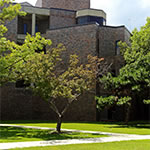Energy auditing and efficiency retrofits have become big business in recent years. As energy prices continue to rise, the cost-benefit analysis of renovating older facilities with new, energy-efficient components—by tightening up a building envelope, swapping out old HVAC equipment, or switching to LED lighting, for example—is looking better and better to the accounting departments of large institutions, many of which face seven-figure annual electric bills.

UIC laboratory building
Ameresco, a global energy-efficiency and green-design company based in Massachusetts, has become a leader in the field. Big players like the US Department of Energy and the Army National Guard have contracted with the company in recent years for assistance in lowering their carbon footprints. Last October, the University of Illinois–Chicago (UIC) signed on for a $63.6 million energy savings performance contract (ESPC), through which they will take on energy-savings projects that pay for themselves. The chosen target was UIC’s science and engineering labs, the type of high-performance buildings where reducing energy demand is notoriously difficult.
“We started looking at this years ago as a way to fund energy-efficiency initiatives,” says Cynthia Klein-Banai, associate chancellor for sustainability at UIC. “We had a preliminary audit with three firms, which helped us determine who should be at the table. We wanted to see how we could integrate these ideas with research and teaching.”
“We looked at retrofitting some of the existing equipment, but it was mostly from the 1960s, so it made more sense at the end of the day to replace it,” says Steve Taggart, Ameresco’s Chicago-based regional director, who is overseeing the UIC project. “We’re replacing almost 400 fume hoods and upgrading the plumbing, lighting, and air handlers.” One of the larger buildings will receive a chilled-beam passive cooling system, a type of water-cooled heat exchanger that is easily integrated in the suspended ceiling structures typical of older buildings. Together with other mechanical system upgrades, it should reduce building energy demand by 50 percent compared to the outdated air handlers currently in operation.
Taggart says he is one of only a few at Ameresco who are not engineers. With a background in business management, he is more attuned to the way an energy budget translates to a building’s operating budget. “Over a 20-year period, the retrofit will fund itself,” he says. The company bills their approach as “cost neutral,” a philosophy that greases the wheels of third-party financing, Taggart says. After the project concludes next fall, UIC expects to reap $1.8 million per year in energy savings. “We expect the project to yield immediate cost savings for UIC, but more importantly, it supports UIC’s Climate Action Plan and will help meet our goal to reduce our carbon emissions by at least 80 percent by 2050,” says Klein-Banai, who holds a doctorate in public health and is also active in research on strategies to measure greenhouse gas emissions.
As big energy consumers latch on to the idea of efficiency retrofitting, performance tracking has become a necessary part of the package. Project managers need to ensure that their goals are actually being met, and they need a way to communicate the process to end users. By the time the project is completed, UIC’s utilities department will have a real-time energy dashboard online that displays consumption by each of the major energy-consuming buildings on campus. “We’re trying to integrate the dashboard in existing monitors in each building,” Klein-Banai says. “The goal is to make the data available—and, hopefully, interesting—to the layperson.”

